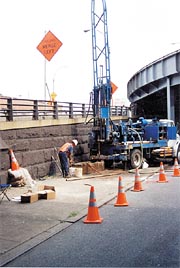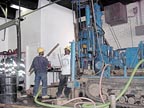
Put a drilling contractor to work in that environment and you quickly -- and correctly -- surmise that it's no place for the timid or feint of heart. And it's doubtful the people at Aquifer Drilling & Testing Inc. (ADT) would have it any other way at all. Company president Len Rexrode says, "Just the logistics of working in New York City with the traffic and utilities and access can make things complicated. And simply getting the permits to open the streets and sidewalks is not for the uninitiated. We have to get the maps and use surface geophysical instruments to make sure we're clear. We don't only rely on the one-call system. We double-check after the markouts already are done. God forbid you hit a 36-inch diameter water main. It's never happened to us, but we've seen it happen to others and the ensuing problems -- interruption of business, flood damage, foundation repairs -- and the accompanying lawsuits are just a horror. There's a lot of risk working in such a high-density area, and we assume all the liability."
Rexrode, a certified professional geologist with more than 20 years experience in mineral, environmental and geotechnical drilling started the company in 1989. ADT currently employs 80 people and runs 45 rigs. Describing those rigs, Rexrode tells us, "We have three big air rotary rigs -- Schramm, Versadrill and Driltech models. The bigger mud rotary rigs we run are two Failings, a Davy Kent and a Canterra rig. We also have 12 Geoprobes. The balance of our rigs are mostly auger -- either truck-mounted, skid-mounted or all-terrain.

Work Performed
"Most of the work we do is environmental and geotechnical," Rexrode explains. "We started out doing environmental work for the most part and then increasingly got into more geotechnical work. The ratio now is about 50:50. A great deal of our work comes through engineering companies that we pre-qualify with. We're invited to bid on projects that aren't advertised. To a lesser degree, there are some bids for the state department of transportation. A lot of our work is directly for New York City. We work with most of the city agencies, including the transit authority, the port authority and the housing authority. The port authority handles the area?s three major airports as well as the ports. With all the ports around the city, we're often having to do barge work. About 80 percent of our work is negotiated. There's not much in the way of drilling that we don't bid on. We don't get involved with the construction drilling for the big caisson work; there's a lot of risk vs. reward in that."Asked if ADT gets involved in residential projects, Rexrode says, "Probably less than five percent of our work is residential."
Aquifer Drilling & Testing's main office is in New Hyde Park, N.Y. Other branches are located in Troy, N.Y., Hartford, Conn., and Tampa, Fla. A separate company, ADT Diamond, has its office in Neptune, N.J. That company, formerly Diamond Drilling, is the only operation that wasn't a start-up. ADT's growth was relatively quick. "We started out with one rig and added three or four rigs a year -- sometimes more," Rexrode explains. "We've been fortunate to have good people on board. We've developed a very good market share by having quality people and quality equipment."
No small part of that can be attributed to ADT's emphasis on professionalism. Stresses Rexrode: "We like to bring a professional image to the work site. I spend $1,000 a month on uniforms. Most of the people we do work for are professionals -- engineers and geologists. Among our key personnel, Bill Poupis, Mike Greenman and Steve Wolf all are degreed geologists; they understand the needs of our clients quite well -- they speak the language, if you will.
"They enjoy working with confidence with other geologists. A lot of times, we're helping the clients understand what they need on a job. They don't always know all they need to know to get their specs right and all. We get a lot of calls from people asking about drilling conditions in different areas of New York City -- the overburden conditions before bedrock or how deep the bedrock is. Some areas are a nightmare for drilling -- really cobbly or lots of boulders -- and are very difficult to get through."
Greenman, with his 35 years experience, has overseen the drilling of more than 70,000 boreholes in the city. If there's a person who knows more about every single square foot of the city -- and everything that's underneath it -- no one can find him. Greenman regularly is called upon for his encyclopedic knowledge of the area.

Getting into Geoprobe
Rexrode explains that ADT was at first reluctant about using the Geoprobe machines. "Environmental companies often would have it as part of their bid package," he notes. "We resisted that for quite a few years, but then decided to go ahead and get the direct-push machine -- and now we have about 12 of them. The drilling conditions are so diverse in New York that at certain sites, you might not be able to get past a few feet because the nature of the soil conditions. Rather than go to a job and fail with that machine, we often recommended to our clients to go with a hollow-stem auger machine, a truck-mounted machine that has more power and more torque. We found that some of our competition was able to use the Geo-probe machines and we were losing some work because of that. So we decided to get one and found that they could be used at a lot of sites and get down deeper than what we originally anticipated. And now we use those probes a lot. We'll often go in and do the preliminary reconnaissance work to find the hot spots, if you will, for the environmental jobs. Then later, we go in with the bigger machine to install the monitoring well or recovery well."
Geothermal work is becoming a bigger part of ADT's operations. "We just completed two big geothermal projects," Rexrode relates. "One was at a high school in Cobleskill, N.Y. We drilled 240 heat loops that were 400 feet deep -- 96,000 linear feet of heat looping to heat and cool the high school. That project took about five months to complete. That type of drilling might become a bigger part of our operations. We're seeing more activity with it. There was a learning curve for us with the geothermal work. It's different, of course, from environmental and geotechnical work. But we are in that market now."

Looking Ahead
After such strong growth in ADT's first 14 years, Rexrode is expecting future growth to be much more moderate. "We're steady right now. There are some fluctuations. Last winter was a tough one for us. Demand for environmental and geotechnical work is driven by regulatory and economic factors. A lot depends on state funding for environmental work, so geotechnical could become a larger part of our business. We're positioned for it either way. We've never decreased in size in our 14 years. We're at a point for management that we're getting pretty high on that curve and any future growth will be more controlled; we'll be on a steady course."And not surprisingly, Rexrode echoes an all-too-familiar refrain when he says, "Finding good drillers always is a challenge for us. A lot of people can be apprehensive about making a move to New York City." They shouldn't be. If they take their cue from Aquifer Drilling & Testing, they'll see that when the challenges can be met with confidence and professionalism, success can be expected.
Report Abusive Comment